Conference Talk Abstract:
Central Cholinergic Systems are Necessary for Organized Responses to Cue
Changes in Rat Serial Pattern LearningStephen B. Fountain & Amber M. Chenoweth (Kent State University)
In serial pattern learning, it is common to find that the transitions to
new chunks of a serial pattern are more difficult to anticipate than
elements within chunks. Providing “phrasing cues” at chunk boundaries can
facilitate learning about these transitions in normal rats. Further, our
lab has found evidence that atropine, a muscarinic cholinergic antagonist,
impairs acquisition of chunk boundaries, regardless of the presence of
phrasing cues. We examined the differences between two groups of rats
given daily i.p. injections of either saline or atropine sulfate (50
mg/kg) and trained to press levers in a specific order (the serial
pattern) for brain-stimulation reward in an octagonal operant chamber. Two
phrasing cue removal probes revealed that both control and
atropine-exposed rats anticipated chunk boundaries. However, the results
also showed that intact central cholinergic systems are necessary for rats
to exhibit organized strategies for dealing with cue changes in transfer
conditions.
Poster Presentation Abstracts:
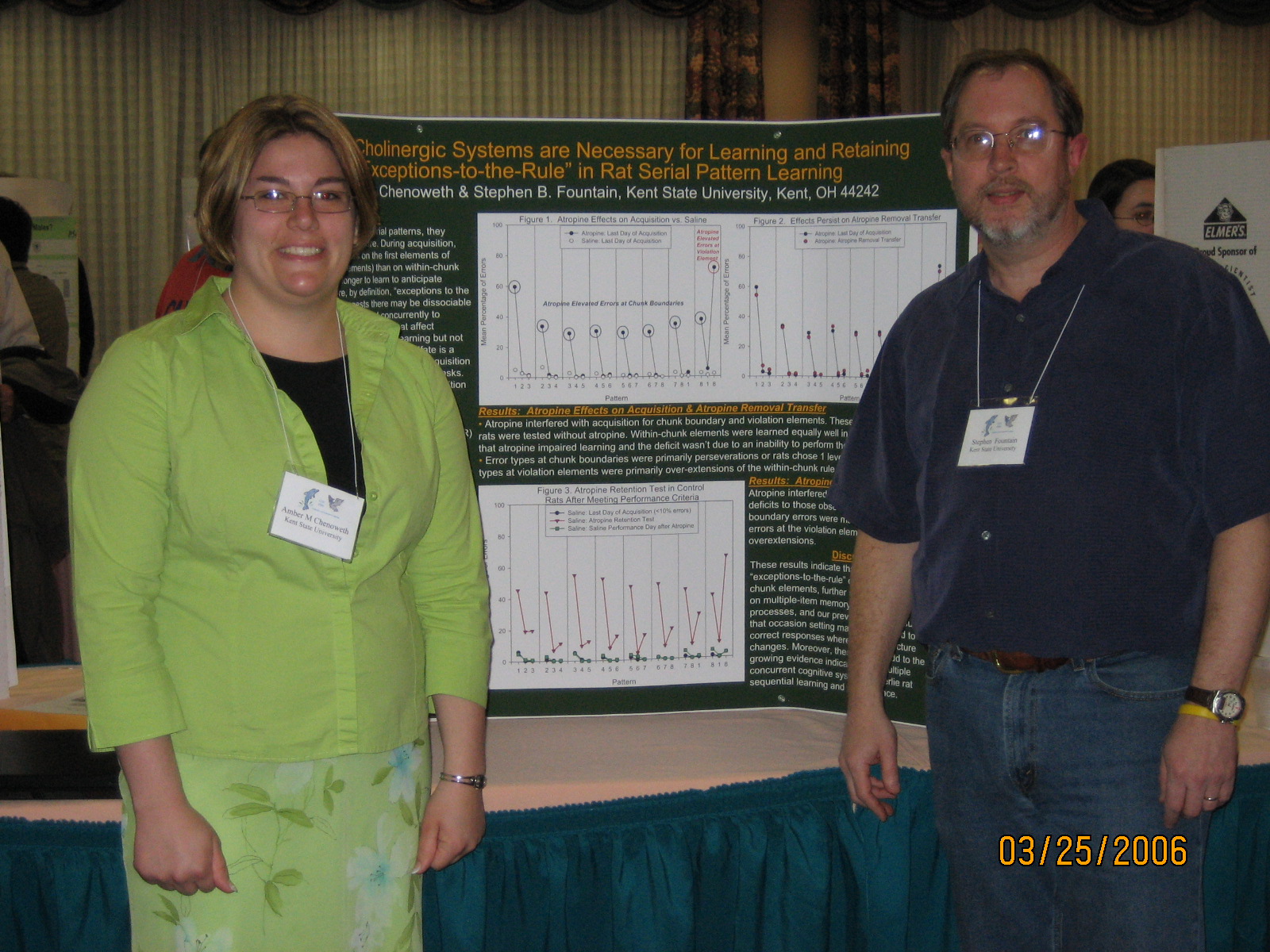
Central Cholinergic Systems are Necessary for Learning and Retaining
“Exceptions-to-the-Rule” in Rat Serial Pattern Learning.
PDF Amber M. Chenoweth & Stephen B. Fountain (Kent State University)
We examined the effects of atropine, a muscarinic cholinergic antagonist,
on acquisition and retention of serial patterns. Rats were given daily i.p. injections of either saline or atropine sulfate (50 mg/kg) and
trained to press levers in a specific order (the serial pattern) for
brain-stimulation reward in an octagonal operant chamber. The two groups
learned the following pattern: 123 234 345 456 567 678 781 818. Atropine
exposure impaired acquisition for chunk boundary elements (the first
element of chunks) and the violation element of the pattern, but did not
impair acquisition for within-chunk elements. Performance was unchanged in
a subsequent drug-free day. Similar deficits were observed in a retention
test where saline-trained rats were exposed to atropine for one day. The
results indicate that intact central cholinergic systems are necessary for
learning and retaining appropriate responses at places in sequences where
pattern structure changes.
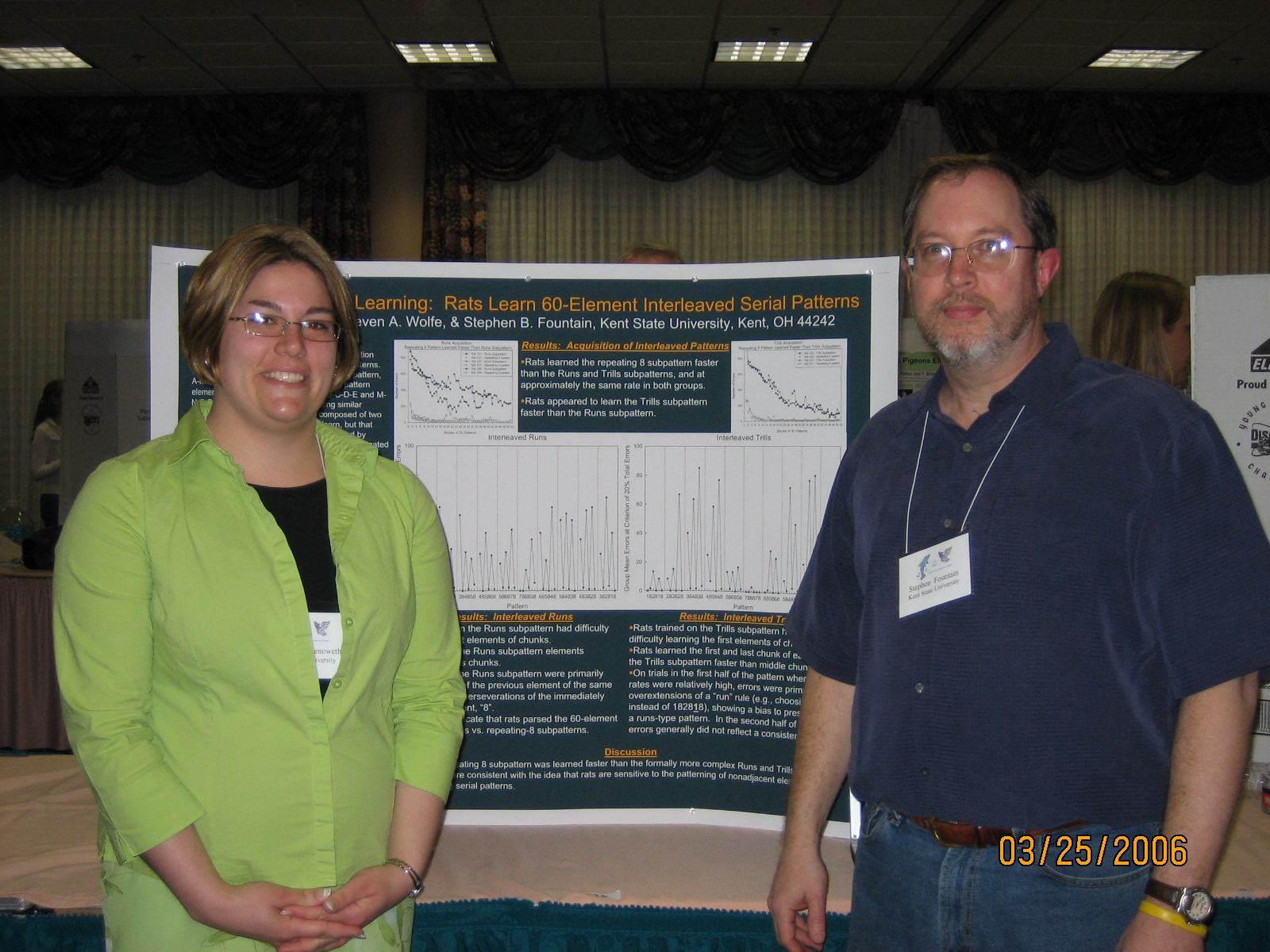
“Extreme” Sequential Learning: Rats Learn 60-Element Interleaved Serial
Patterns. PDF
Amber M. Chenoweth, Steven A. Wolfe, & Stephen B. Fountain (Kent State
University)
Humans have the ability to chunk together information from nonadjacent
serial positions in sequential patterns. For example, human subjects
typically learn the pattern, A-M-B-N-C-O-D-P-E-Q, by cognitively sorting
pattern elements into component interleaved subpatterns: A-B-C-D-E and
M-N-O-P-Q. Our earlier studies demonstrating similar capacities in rats
showed that patterns composed of two interleaved subpatterns were
difficult to learn, but that subpattern difficulty was nonetheless
determined by subpattern structure. In the present study, we investigated
rats' ability to learn a 60-element interleaved pattern where one
subpattern was one of two 30-element hierarchically organized patterns
composed of either “runs” or “trills” chunks. The other subpattern was
composed of a repeating element. Subpattern acquisition rates were
correlated with the structural properties of component subpatterns. The
results indicate that rats are sensitive to the patterning of nonadjacent
elements even in extremely long serial patterns and that several factors
contribute to pattern tracking in interleaved patterns.
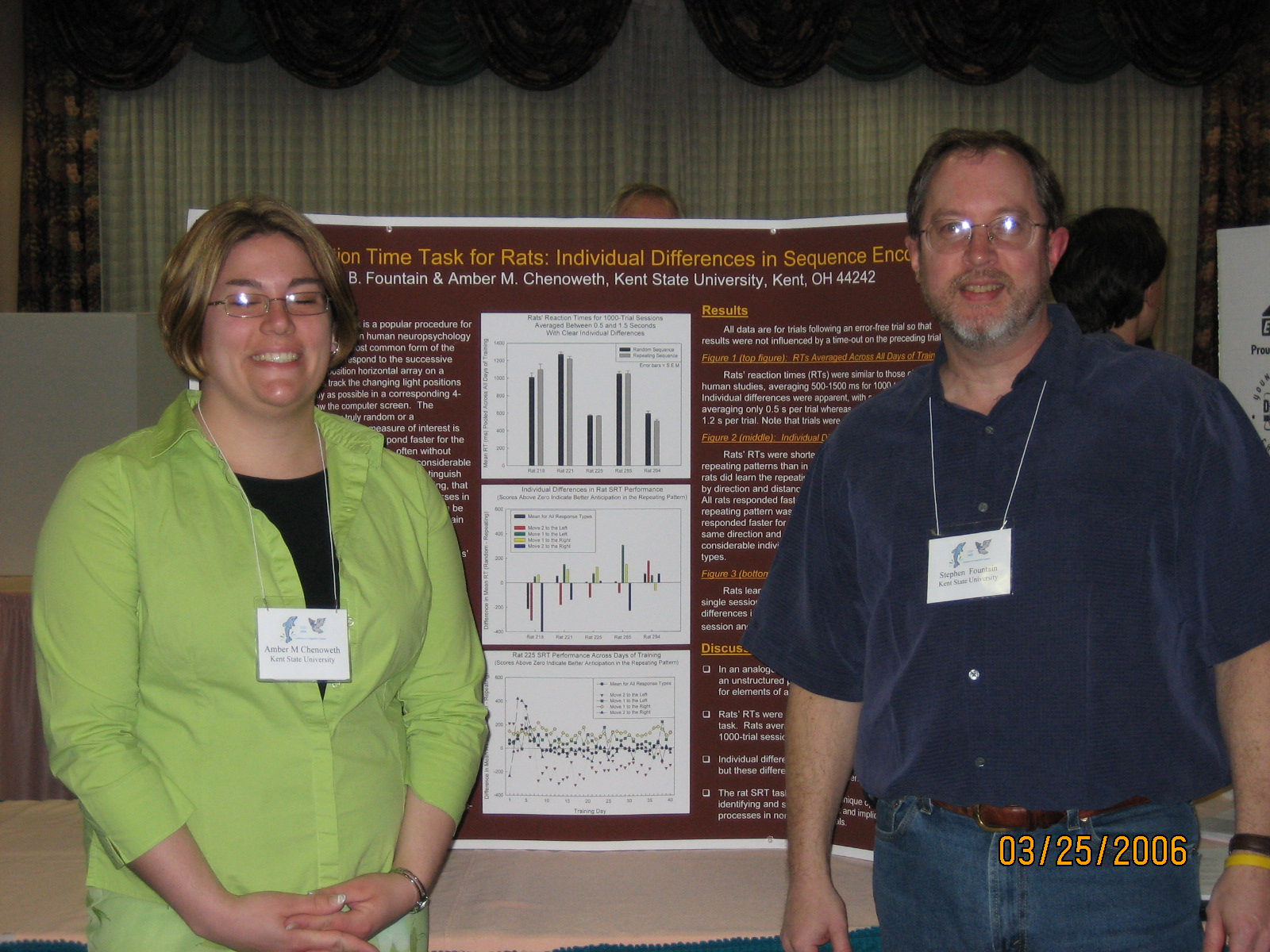
A Serial Reaction Time Task for Rats: Individual Differences in Sequence
Encoding. PDF
Stephen B. Fountain & Amber M. Chenoweth (Kent State University)
The serial reaction time (SRT) task is a popular procedure for assessing
sequential learning capacity in human neuropsychology and functional
imaging studies. We developed an operant SRT procedure for rats that is a
close analogue of the human SRT procedure. It encourages rats to respond
as quickly as possible to the successive positions of a light that appears
in one of four positions in a horizontal array. Rats press corresponding
levers under the array of lights for brief pulses of hypothalamic
brain-stimulation reward. “Reaction times” (RTs) are similar to those
observed in human studies, averaging 1000 msec or less for 1000-trial
sessions. Rats learned a simple repeating pattern in this task in a single
session; RTs were shorter for repeating patterns than for random sequences
presented in blocks in the same session. Rats showed individual
differences in sequence encoding that appeared in their first session and
remained consistent across sessions.
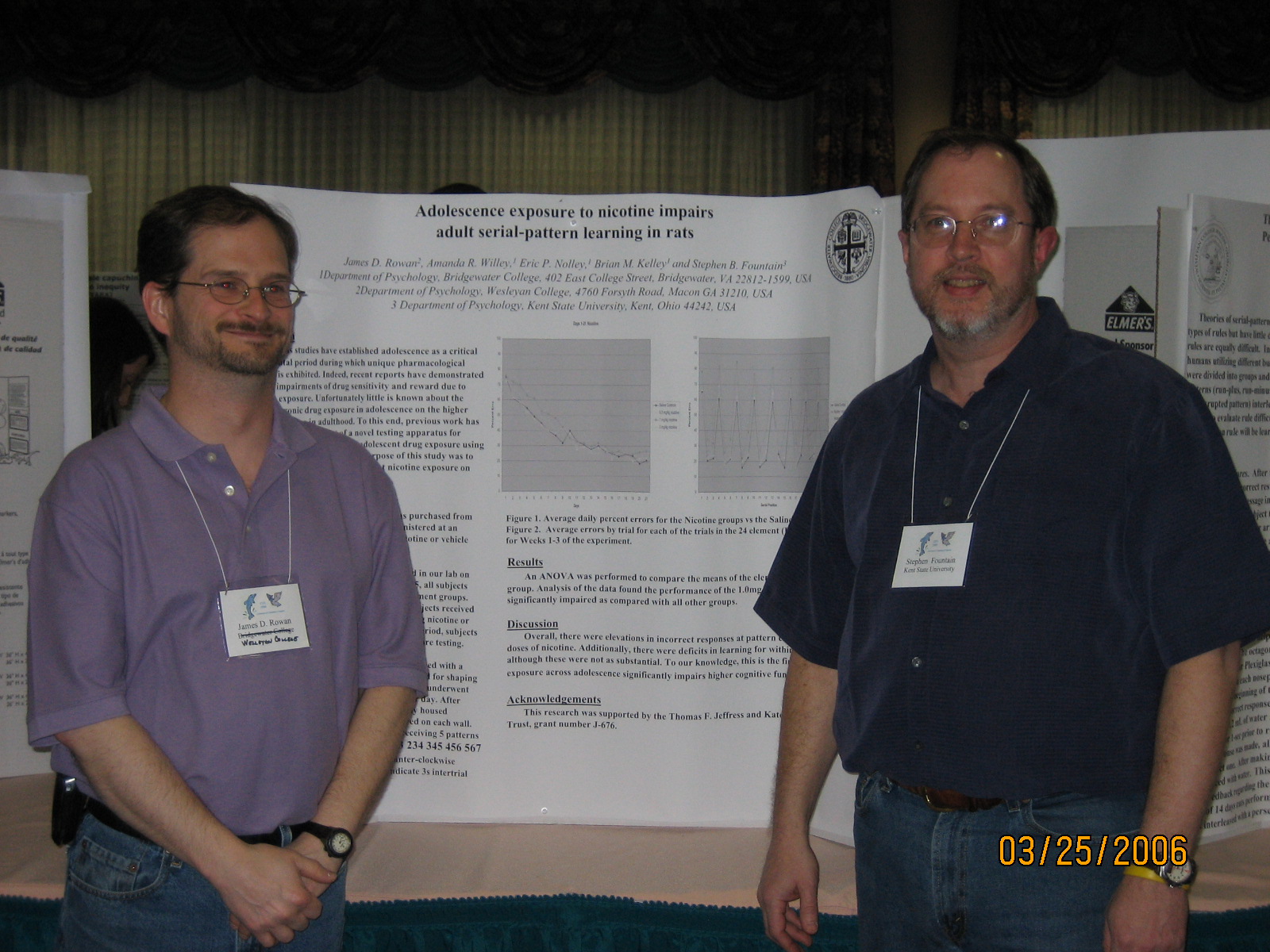
Adolescence Exposure to Nicotine Impairs Adult
Serial-Pattern Learning in Rats
James D. Rowan (Wesleyan College), Amanda R. Willey, Eric P. Nolley, Brian
M. Kelley (Bridgewater College), and Stephen B. Fountain (Kent State
University)
This experiment examines the effects of early exposure to Nicotine on
adult higher cognitive function. Weanling rats were injected 5 days a week
for 5 weeks with 3.0, 1.0, 0.3 mg/kg nicotine or saline based on body
weight (1 ml/kg). After 5 weeks off, all subjects were trained on the
perfect run pattern (123 234 345 456 567 678 781 812) for 28 days
receiving 5 patterns a day. Analysis of the data found the performance of
the 1.0mg/kg nicotine group was significantly impaired compared with all
other groups. To our knowledge, this is the first evidence that long-term,
low-level adolescent nicotine exposure significantly impairs higher
cognitive functioning in adulthood.
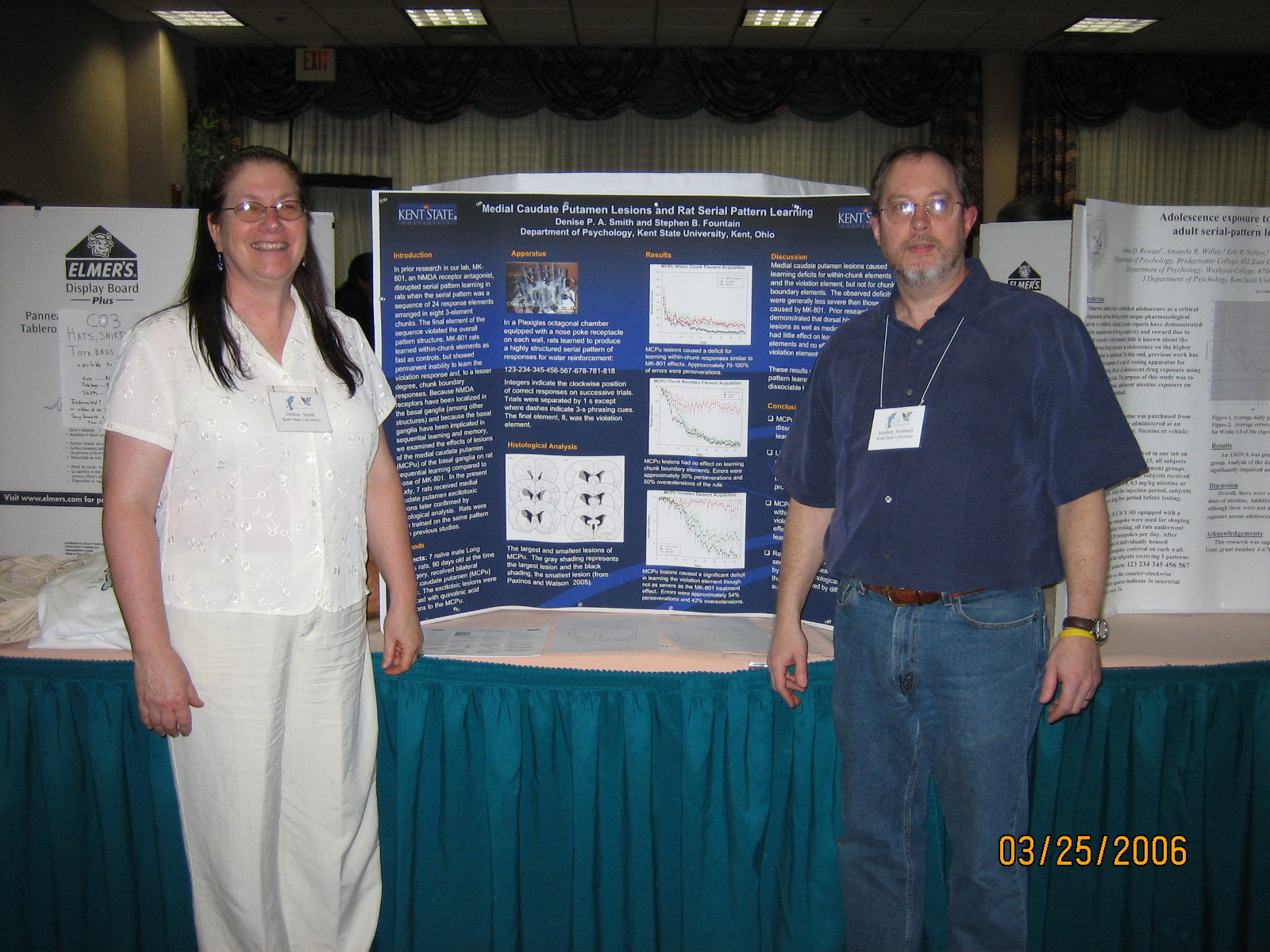
Medial Caudate Putamen Lesions and Rat Serial Pattern Learning.
PDF
Denise P.A. Smith & Stephen B.
Fountain (Kent State University)
In prior research in our lab, MK-801, an NMDA receptor antagonist,
disrupted serial pattern learning in rats when the serial pattern was a
sequence of 24 response elements arranged in eight 3-element chunks. The
final element of the sequence violated the overall pattern structure.
MK-801 rats learned within-chunk elements as fast as controls, but showed
permanent inability to learn the violation response and, to a lesser
degree, chunk boundary responses. In the present study, 6 rats received
medial caudate putamen excitotoxic lesions later confirmed by histological
analysis. Rats were then trained on the same pattern as in previous
studies. Medial caudate putamen lesions caused learning deficits for
within-chunk elements and the violation element, but not for
chunk-boundary elements. Deficits were generally less severe than those
caused by MK-801. These results support the claim that serial pattern
learning is subserved by multiple dissociable brain and cognitive systems.
Other Activities:

We are always trying to move ahead in the field... Professor Rowan
shows excellent form.
(Trying to take our work seriously without taking ourselves too
seriously.)
|